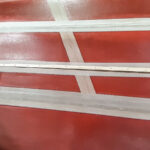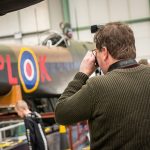As many readers will remember, Vickers Wellington T.Mk.X MF628 has been in the care of the Michael Beetham Conservation Center at RAF Museum Midlands (formerly RAF Museum Cosford) for several years now. A team of highly skill professionals and volunteers has been sympathetically attending to the airframe, addressing any corrosion issues and making sure that this extremely rare medium bomber, one of just two complete examples extant, will remain in excellent condition for many more generations to come. Periodically, we have published RAF Museum updates recording conservation progress for this exciting project, with the latest description reproduced below.
“The Vickers Wellington undergoing conservation at our Midlands site is starting to take shape, it now has a fully covered fuselage, and the cockpit canopy has been attached.
Since our last update, the top fuselage section has been covered in Irish linen and so far, two coats of red dope and one clear coat have been applied.
Between each layer of dope, the fuselage receives a light sanding before the next coat is applied, ensuring we get a smooth finish. Our Technicians will be working hard over the coming months to apply seven more clear coats of dope, followed by two silver coats, and then finishing with a Bomber Command colour scheme.
If you’ve ever wondered what the serrated edge strips are for, these are placed over the wooden clamp strips to add an extra layer of protection where the linen is sewn onto the aircraft frame. The light sanding between dope coats helps to smooth these edges giving a better finish.
We’re really pleased to see the cockpit canopy back on the aircraft. This has been lovingly cleaned, restored, and refitted by our team of engineering Volunteers, and looks as good as new.
Keep a look out for more Wellington updates over the coming months as we move closer to the aircraft going on public display at our Midlands site in 2023!”




































